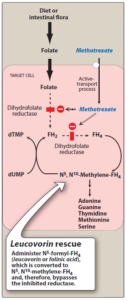- Methotrexate is chemotherapeutic agent and immunosuppressant used to treat various cancers and autoimmune diseases. It is an antimetabolite (chemical agent which are structurally like metabolites and block their action). Chemically, is 4-amino substituted folic acid analogue which acts as folic acid antagonist.
- It is included in World Health Organization’s List of Essential Medicines and is also available as generic medicine.
Indications of methotrexate
- In acute lymphatic leukemia in children.
- Used in combination therapy to treat choriocarcinoma and soft tissue sarcoma.
- Used in combination with other chemotherapeutic agents to treat carcinoma of breast, head, neck, ovary and bladder. cancer and acute myeloid leukemia.
- High dose methotrexate with leucoverin rescue (HDM-L) is used as adjuvant therapy for osteosarcoma.
- In psoriasis.
- In rheumatoid arthritis.
- As immunosuppressant in steroid resistant asthma, Crohn’s disease and transplant rejection.
- In medical abortions.
Mechanism of action of methotrexate

Figure- Mechanism of action of Methotrexate (FH2 – Dihydrofolate, FH4– Tetrahydrofolate, dTMP- deoxythymidine monophosphate, dUMP- deoxyuridine monophosphate)
- Methotrexate is structurally similar to folic acid. Folic acid is converted by the enzyme dihydrofolate reductase (DHFR) to tetrahydrofolic acid (THF). THF play important role in synthesis of precursors of DNA (thymidylate and purines) and RNA (purines).
- Methotrexate competes with folic acid for the enzyme DHFR and bind irreversibly to the enzyme. This causes inhibition of THF production. Lack of THF results in inhibition of DNA synthesis and cell replication.
- It kills cells during the S phase of the cell cycle and is most effective when cells are proliferating rapidly. It is only partially selective for tumor cells and is toxic to all rapidly dividing normal cells.
Pharmacological Actions of methotrexate
Cytotoxic actions
- It inhibits erythropoiesis, myelopoiesis and can cause aplasia of the bone. Methotrexate can cross placental barrier and inhibit embryogenesis which can cause fetal abnormalities and death.
- It can cause ulceration of oral and intestinal mucosa.
Immunosuppressive actions
- Methotrexate is a potent immunosuppressant. It prevents clonal expansion of both B and T lymphocytes.
Anti-inflammatory actions
- When used in small dose, it interferes with release of inflammatory cytokines like IL-2, IL-6 and TNF- α and reduces lymphocytic proliferation, rheumatoid factor production.
Pharmacokinetics
- It is administered by oral, intramuscular, intravenous and intrathecal route. It has short half-life od approximately 6 hours.
- Around 50% of methotrexate binds to plasma proteins. It gets distributed in intestinal epithelium, kidney, liver, pleural effusion and skin.
- It disappears from blood rapidly and remain for longer time in tissues than in folate. Hence, it shows prolonged inhibitory effect. It cannot cross BBB (Blood Brain Barrier) easily so has poor CSF (Cerebrospinal fluid) concentration.
- It undergoes hydroxylation to form 7-hydroxymethotrexate which is less water soluble and less active than methotrexate. Its less water solubility may lead to crystalluria.
- Both parent drug and its metabolites are excreted through urine. Some percentage may excrete through feces due to enterohepatic circulation.
Adverse effects
- Side effects of high dose may be life threatening.
- Most of the adverse effects occur due to deficiency of THF. Such adverse effects include megaloblastic anemia, thrombocytopenia, leucopenia and aplasia. Other common effects include nausea, vomiting, diarrhea, alopecia, dermatitis and liver damage.
- When used in high dose, it causes elevation of hepatic enzymes which is reversible. Severe hepatotoxicity may occur.
- Acute kidney injury can occur in about 2-12% of patients.
- It can induce acute, subacute or chronic neurotoxicity which is mostly observed after intrathecal or intravenous administration. Pneumonitis is serious but infrequent side effect of low dose methotrexate.
- Some general things to be followed to reduce methotrexate toxicity are assessment of renal function after its administration, assessment of plasma methotrexate concentration, maintaining adequate hydration, maintaining adequate alkaline urine pH and avoiding drug interactions. Leucoverin rescue is effective in preventing myelosuppression, gastrointestinal toxicity and neurotoxicity related to high dose methotrexate treatment.
Drug Interactions
- Some drugs which reduce gastric acid like proton pump inhibitors may increase its concentration and increase its side effects. Drugs like penicillin, probenecid increase its toxicity by decreasing elimination.
- Drugs like aminoglycosides and neomycin may decrease gastrointestinal absorption of methotrexate. Immunosuppressants like cyclosporine may potentiate its hematologic effects and hence potentiate toxicity.
- Concurrent administration with drugs like chloramphenicol, asparaginase and leflunomide may cause kidney problems. Drugs like penicillin, phenytoin, tetracyclines and pyrimethamine may cause liver problems.
Contraindications
Contraindicated in following conditions:
- Patients who are hypersensitive to this drug.
- In pregnancy and nursing mothers.
- Patients with alcoholism, alcoholic liver disease or other liver disease.
- Patients with immunodeficiency syndrome, preexisting blood dyscrasias and severe renal impairment.
References
- Cronstein BN, Aune TM. Methotrexate and its mechanisms of action in inflammatory arthritis. Nature Reviews Rheumatology. 2020; 16: 145–154.
- Gaies E, Jebabli N, Trabelsi S, Salouage I, Charfi R, Lakhal M et al. Methotrexate Side Effects: Review Article. J Drug Metab Toxicol. 2012, 3:4.
- Howard SC, McCormick J, Pui CH, Buddington RK, Harveyd RD. Preventing and Managing Toxicities of High-Dose Methotrexate. Oncologist. 2016; 21(12): 1471–1482.
- Pharmacology and Pharmacotherapeutics. 24th edition.
- Goodman and Gillman Manual of Pharmacology and Therapeutics.
- Lippincott Illustrated Reviews Pharmacology, 6th edition.